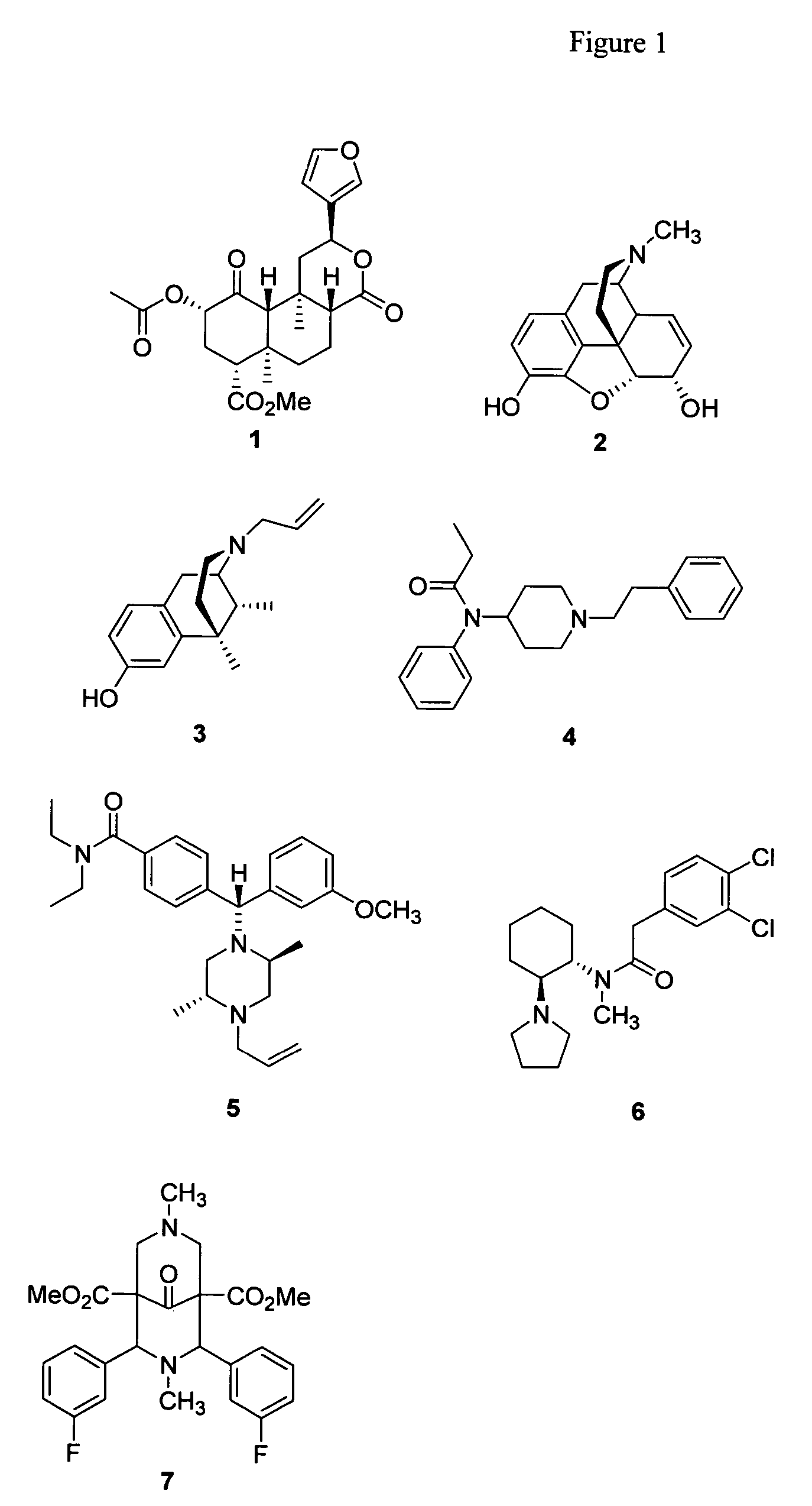Opioid receptor ligands and methods for their preparation
a technology of opioid receptors and ligands, which is applied in the direction of heterocyclic compound active ingredients, biocide, drug compositions, etc., can solve the problems of tolerance, dependence, unsatisfactory side effects, and respiratory depression, and achieve the effect of modulating the action of the receptor
- Summary
- Abstract
- Description
- Claims
- Application Information
AI Technical Summary
Benefits of technology
Problems solved by technology
Method used
Image
Examples
example 1
Isolation of Salvinorin A (1)
[0183]Dried Salvia divinorum leaves (1.5 kg), obtained commercially from Ethnogens.com, were ground to a fine powder and percolated with acetone (5×4 L). The acetone extract was concentrated under reduced pressure to afford a crude green gum (93 g), which was subjected to column chromatography on silica gel with elution in n-hexanes containing increasing amounts EtOAc. Fractions eluting in 20% n-hexanes / EtOAc contained salvinorin A (TLC) and other minor diterpenes and some pigmented material. These fractions were pooled and concentrated in vacuo to give a green gum (24 g). A mixture of the crude green gum, acetic anhydride (50 mL, 530 mmol) and DMAP (0.2 g) in CH2Cl2 (250 mL) was stirred at RT overnight. The CH2Cl2 solution was washed sequentially with 1N HCl (2×500 mL), 2N NaOH (100 mL), and H2O (2×100 mL). The CH2Cl2 solution was dried (Na2SO4) and the solvent was removed under reduced pressure to afford a yellow-green gum (23 g). The resulting gum was...
example 2
Ammonolysis of Salvinorin A (1)
[0184]A mixture of NH3 (6 mL of a 7N solution in MeOH) and 1 (0.4 g, 1.12 mmol) in absolute MeOH (100 mL) was stirred at room temperature overnight. The resulting precipitate was collected by filtration and washed with cold n-hexanes (250 mL) and dried to afford 0.2 g of salvinorin B (8a) as a white solid, mp 211-214° C. (Valdes III, L. J.; Butler, W. M.; Hatfield, G. M.; Paul, A. G.; Koreeda, M. Divinorin A, J. Org. Chem. 1984, 49, 4716-4720). The combined filtrate was evaporated to dryness under reduced pressure and the residue was subjected to column chromatography. Eluting in gradient fashion (20% EtOAc / n-hexanes −60% EtOAc / n-hexanes) afforded 8a (0.06 g) and (2S,4aR,6aR,7R,9S,10aS,10bR)-9-(hydroxy)-2-(3-furanyl)dodecahydro-6a,10b-dimethyl-4,10-dioxo-2H-naphtho[2,1-c]pyran-7-carboxylic acid methyl ester (8b, 0.06 g);). 1H NMR (CDCl3): δ 1.18 (3H, s, H-19); 1.47 (3H, s, H-20); 1.59-1.66 (3H, m, H-7α,β and H-11β); 1.84 (1H, ddd, J=3.0, 3.0, 9.9 Hz, H...
example 3
(2S,4aS,6aR,7R,9S,10aS,10bR)-9-(hydroxy)-2-(3-furanyl)dodecahydro-6a,10b-dimethyl-4,10-dioxo-2H-naphtho[2,1-c]pyran-7-carboxylic acid methyl ester (8a)
[0185]A mixture of 1 (3.5 g, 8.0 mmol) and Na2CO3 (3.4 g, 32.2 mmol) in absolute MeOH (150 mL) was stirred at room temperature for 4 b. The solvent was removed under reduced pressure and CH2Cl2 (500 mL) was added to the crude residue. The organic extract was washed successively with 2N HCl (50 mL) and saturated NaCl (50 mL) and dried (Na2SO4). The solvent was removed under reduced pressure and MeOH (100 mL) was added to the residue. The resulting solid was collected by filtration and dried to afford 2.4 g (77%) of 8a as a white solid, mp 211-214° C. (Lit. 213-216° C.).
PUM
| Property | Measurement | Unit |
|---|---|---|
| temperature | aaaaa | aaaaa |
| pharmaceutical composition | aaaaa | aaaaa |
| Rh | aaaaa | aaaaa |
Abstract
Description
Claims
Application Information
 Login to View More
Login to View More - R&D
- Intellectual Property
- Life Sciences
- Materials
- Tech Scout
- Unparalleled Data Quality
- Higher Quality Content
- 60% Fewer Hallucinations
Browse by: Latest US Patents, China's latest patents, Technical Efficacy Thesaurus, Application Domain, Technology Topic, Popular Technical Reports.
© 2025 PatSnap. All rights reserved.Legal|Privacy policy|Modern Slavery Act Transparency Statement|Sitemap|About US| Contact US: help@patsnap.com



